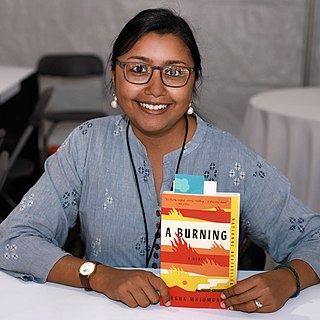
Simon & Schuster LLC is an American publishing company owned by Kohlberg Kravis Roberts. It was founded in New York City on January 2, 1924, by Richard L. Simon and M. Lincoln Schuster. Along with Penguin Random House, Hachette, HarperCollins and Macmillan Publishers, Simon & Schuster is considered one of the 'Big Five' English language publishers. As of 2017 Simon & Schuster was the third largest publisher in the United States, publishing 2,000 titles annually under 35 different imprints.

Holly Black is an American writer and editor best known for her children's and young adult fiction. Her most recent work is the New York Times bestselling young adult Folk of the Air series. She is also well known for The Spiderwick Chronicles, a series of children's fantasy books she created with writer and illustrator Tony DiTerlizzi, and her debut trilogy of young adult novels officially called the Modern Faerie Tales. Black has won an Eisner Award, a Lodestar Award, a Nebula Award, and a Newbery Honor.

Raina Telgemeier is an American cartoonist. Her works include the autobiographical webcomic Smile, which was published as a full-color middle grade graphic novel in February 2010, and the follow-up Sisters and the fiction graphic novel Drama, all of which have been on The New York Times Best Seller lists. She has also written and illustrated the graphic novels Ghosts and Guts as well as four graphic novels adapted from The Baby-Sitters Club stories by Ann M. Martin.

Charles Chowkai Yu is an American writer. He is the author of the novels How to Live Safely in a Science Fictional Universe and Interior Chinatown, as well as the short-story collections Third Class Superhero and Sorry Please Thank You. In 2007 he was named a "5 under 35" honoree by the National Book Foundation. In 2020, Interior Chinatown won the National Book Award for fiction.

Dara Horn is an American novelist, essayist, and professor of literature. She has written five novels and in 2021, released a nonfiction essay collection titled People Love Dead Jews, which was a finalist for the 2021 Kirkus Prize in nonfiction. She won the Edward Lewis Wallant Award in 2002, the National Jewish Book Award in 2003, 2006, and 2021, and the Harold U. Ribalow Prize in 2007.
Thomas Boss Congdon Jr. was an American book editor who worked on Russell Baker's memoir Growing Up, Peter Benchley's bestselling novel Jaws, and David Halberstam's 1986 work The Reckoning, as well as the infamous Michelle Remembers, an unreliable account of child abuse that contributed to the Satanic panic. He ultimately establishing his own publishing house.

Lawrence Osborne is a British novelist and journalist who is currently residing in Bangkok. Osborne was educated at Fitzwilliam College, Cambridge, and at Harvard University, and has since led a nomadic life, residing for years in Poland, France, Italy, Morocco, the United States, Mexico, Thailand, and Istanbul.

Life After Life is a 2013 novel by Kate Atkinson. It is the first of two novels about the Todd family. The second, A God in Ruins, was published in 2015. Life After Life garnered acclaim from critics.

Patricia Lockwood is an American poet, novelist, and essayist. Her 2021 debut novel, No One Is Talking About This, won the Dylan Thomas Prize. Her 2017 memoir Priestdaddy won the Thurber Prize for American Humor. Her poetry collections include Motherland Fatherland Homelandsexuals, a 2014 New York Times Notable Book. Since 2019, she has been a contributing editor for London Review of Books.

Robert Costa is an American political reporter who is the chief election and campaign correspondent for CBS News. Prior to joining CBS in 2022, Costa was a longtime national political reporter for The Washington Post. Previously, he was a political analyst for NBC News and MSNBC and the moderator and managing editor of Washington Week on PBS. He is the co-author with Bob Woodward of Peril, a # 1 New York Times bestseller on the final days of the Trump presidency, including the 2021 United States Capitol attack.

Jami Attenberg is an American fiction writer and essayist. She is the author of a short story collection, six novels, including the best-seller The Middlesteins (2012), and a memoir, I Came All ThisWay to Meet You (2022).
Casey Cep is an American author and journalist. Cep is a staff writer at The New Yorker, and her work has appeared in The New York Times, The Paris Review, The New Republic, and other publications. Cep's debut non-fiction book, published by Knopf, Furious Hours: Murder, Fraud, and the Last Trial of Harper Lee (2019), tells the story of how Harper Lee worked on, but ultimately failed to publish, an account of a murder trial that happened in Alabama in 1977.

Fatima Farheen Mirza is an American novelist best known for her novel A Place for Us (2018), which was a New York Times Best Seller. She was also honored by the National Book Award Foundation as a "5 Under 35" Honoree in 2020.

Megha Majumdar is an Indian novelist who lives in New York City. Her debut novel, A Burning, was a New York Times best seller, won the Sahitya Akademi Yuva Puraskar award in 2021 and a Whiting Award in 2022.

Just Mercy: A Story of Justice and Redemption (2014) is a memoir by American attorney Bryan Stevenson that documents his career defending disadvantaged clients. The book, focusing on injustices in the United States judicial system, alternates chapters between documenting Stevenson's efforts to overturn the wrongful conviction of Walter McMillian and his work on other cases, including children who receive life sentences, and other poor or marginalized clients.
This article contains information about the literary events and publications of 2021.
Lucy Foley, is a British author of contemporary, historical fiction and mystery novels. Her novels The Paris Apartment and The Guest List are New York Times best sellers.

Patina is a young adult novel by Jason Reynolds, published August 29, 2017 by Atheneum. It is the second book in Reynold's Track series, preceded by Ghost (2016) and followed by Sunny (2018) and Lu (2018).
Emily Henry is an American author who is best known for her New York Times bestselling romance novels Beach Read, People We Meet on Vacation, Book Lovers, and Happy Place.

"What Is the Best Work of American Fiction of the Last 25 Years?" is an informal opinion poll conducted in 2006 by the New York Times Book Review (NYTBR) to determine "the single best work of American fiction published in the last 25 years." Eligible works were those written by an American author and published during the quarter-century period from 1980 through 2005. The poll was conducted by NYTBR editor Sam Tanenhaus, who sent letters to literary figures requesting their participation and received 124 responses. The results were published on May 21, 2006, in the Sunday edition of the New York Times. An essay by A. O. Scott, titled "In Search of the Best", reflected on the results and the premise of the "Great American Novel".















